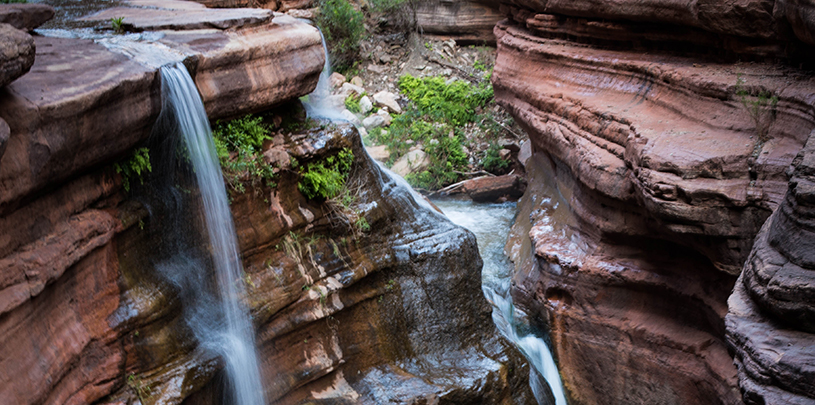
 by Roger Clark, Grand Canyon Director
by Roger Clark, Grand Canyon Director
A recurring proposal to build a mega-resort on the doorstep of Grand Canyon National Park is back. The massive development threatens to guzzle up the Grand Canyon’s precious waters.
The gateway town of Tusayan and its business partner, Stilo Development Group, aim to build thousands of housing units and nearly 1.8 million square feet of retail space, hotels, restaurants, and other commercial developments on two parcels of private land, surrounded by the Kaibab National Forest and adjacent to the national park. But first, they need approval from the Forest Service to build new paved roads and run utilities through the forest to serve the massive development project.
View in full screen (suggested for mobile)
The Forest Service rejected a 2014 application from Stilo because the company’s proposed mega-development was not in the public interest and was harmful to the Grand Canyon. The company submitted a similar proposal in 2019, then revised it earlier this year. While the company suggests that this new proposal is less problematic than previous versions, it is largely unchanged and still threatens harm to the Grand Canyon and the public interest.
Water is a limiting factor for any new development in and around the Grand Canyon. In response to the public outcry against Stilo’s 2014 proposal to supply its new development with groundwater, the company’s 2019 proposal agreed to a “complete prohibition on the use of groundwater” for commercial uses. But the company did not make the same commitment for groundwater to supply its thousands of new residential units, a huge increase for a town with a population of about 600.
 Tusayan has consumed more than a billion gallons of groundwater — pumped from wells 3,000 feet deep — since the first well was drilled more than three decades ago. Stilo proposes to pump water from the town’s existing wells just outside Grand Canyon National Park to meet the needs of thousands of new residential units.
Tusayan has consumed more than a billion gallons of groundwater — pumped from wells 3,000 feet deep — since the first well was drilled more than three decades ago. Stilo proposes to pump water from the town’s existing wells just outside Grand Canyon National Park to meet the needs of thousands of new residential units.
The National Park Service has estimated that those residential additions could increase groundwater pumping by more than 150 million gallons per year. Added to Tusayan’s ongoing commercial and residential groundwater use, Stilo’s new groundwater withdrawals could diminish or totally dry up dozens of springs that emerge from the Redwall-Muav aquifer, deep beneath Grand Canyon’s south rim.
And alarmingly, while the company’s 2019 proposal promised a complete prohibition of groundwater for commercial use, the revised proposal submitted earlier this year reverses that promise. The most recent proposal would allow trucks to import groundwater pumped from the Redwall-Muav aquifer and would even allow the company to pump groundwater from the nearby town of Williams, which itself has faced severe water shortages.
The Havasupai Tribe strongly opposes more groundwater use, which threatens the sole source of drinking water for Supai Village, and the tribe’s tourism-based economy.
Especially during these chaotic times, the Grand Canyon Trust is committed to supporting the communities where we work. Tusayan residents deserve home ownership and affordable housing, fair wages and benefits, and essential services. The Trust recognizes our neighbors’ needs and accepts Tusayan Mayor Craig Sanderson’s challenge to work together to address real problems.
We support ideas and proposals that solve more problems than they cause. For example, it may be possible to meet Tusayan’s residential housing and water needs without developing the two private parcels as proposed or putting the region’s groundwater at further risk.
Water is fundamental to Grand Canyon’s well-being and necessary for people — from Havasupai tribal members to workers who live inside the national park, or in Tusayan, Valle, and Williams — to survive and flourish.
The Trust is asking the Forest Service to once again reject the company’s revised proposal because it is not in the public interest and would harm the Grand Canyon. Stilo already has access to its property; the new paved roads and utilities are only necessary to turn the parcels into a mega-resort. Supplying thousands of new housing units, and potentially millions of square feet of commercial development, with groundwater from the local aquifer likely will diminish or completely exhaust springs and seeps on the South Rim.
In addition to groundwater-related impacts, the massive development and associated traffic would brighten the park’s strikingly dark skies, stress the park’s aging infrastructure, degrade air quality, and fragment important wildlife habitat shared by the Kaibab National Forest and Grand Canyon National Park.
Please be safe and, above all else, take care of yourself and your families. If you’re able, please write to the Kaibab National Forest with your thoughts about Stilo’s problematic proposal. Mitigating harm to the Grand Canyon’s seeps and springs is vital; to do this, the region’s groundwater must be protected. Public land, people, and precious water should be more than pathways to boost corporate profits.
Take Action. Urge the U.S. Forest Service to deny road and utility easements for the development and require a full environmental review.
The Colorado River below Glen Canyon Dam is heating up. Find out why.
Read MoreGroundwater pumping at a uranium mine near the Grand Canyon will affect the canyon's springs, scientists says.
Read MoreArizona Governor Katie Hobbs is the latest elected official to call for an environmental review of Pinyon Plain uranium mine.
Read More